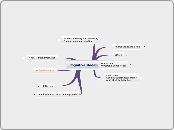Cognitive Modelling
Representing the Brain
A computational approach: Whaty is goal? How can it be computed in an algorithm.Input -> Internal representation (algorithm) -> output
Models can be built to predict performance
GOMS
Goals (aims of user)Operators (possible interactions e.g. clicking a mouse, slecting a key)Methods (Sequences of sub goals & operators to achieve a goal)Selection (rules by which a choice is made out of alternative options)
Predictive model. Supports evaluation before spending time building the system
Lends ideas taken from Task Analysis. Goals -> sub goals -> then one (or more) of the 4 items above
E.g. Method for goal: delete object1. Accomplish goal: move object to trash2. return with goal accomplished
Can also use IF, AND, OR statements
Modelling number of actions (as opposed to just time)
ACT-R - A theory for simulating& understanding cognition
Difference with GOMS (only expert), Cog Architectures can allow modeling of users learning the system
ACT-R Most popular. Builds on theory of rational analysis
Cognition proceeeds via a pattern matching process that attempts to find production rules with certain conditions that match the current contents of the buffers. When a match is found, theproduction fires the action. These actions will be associated with appropriate latency.
Declarative memory, structured as Chunks
things we know, e.g. facts
Procedural memory, structured as Productions
How to do things
Each chunk in declarative memory is based on the notion of activation.Each chunk has a level of activation which determines availability based on recency & frequency of use
E.g. children suming 3 + 4. count up? or recall it?
The second implementation of rational analysis is based on choosing between production rules.We optimise expected utility. ACT-R simulates this by giving each production an expected Probabilityand expected Cost. It is assumed with choose based on optimsing efficiency
Model Human Processor
Memories defined by storage capacity, decay time, type of coding
Processros defined by cycle time
KLM GOMSKeystroke-Level Model
Restricted ver of GOMS. Does not include Goals or Selection rules.States operators and methods to perform a task
All operators have an execution time.KLM-GOMS is mainly used for predicting time it takes to complete a task By the SUM of all operators.
The 8 Standard Operators:B Press a key (0.28s)T(n) Type a sequence of n chars on keyboard (n x Ks)P Point the mouse to a target on the display (1.1s)B Press or release mouse button (0.1s)BB Click the mouse button (0.2s)H Move hands between mouse and keyboard (0.4s)M Mental act of routine thinking or perceptin (1.2s)W(t) Wait time for system response (t s)
Different attributes of user or environment may change the time. e.g. expert vs beginner typists.
CPM COMSCognitive perceptual-motoror Critical Path Method
Theoretical basis is Model Human Processer, Card et al 1983
Assumes that Cognitive, perceptual & motor operators performed run in parallel.This is represented in a schedule chart ['PERT'].Perceptual top line. Cog middle line. Motor bottom line.
Critical path is the sequence of operators with the longest overal duration.This determines shortest time to complete the task.
Rational Analysis
Fitts Law
Models Movement time for selection
"Targets that are small/further away require more time to acquire"
Increases with distance to targetDecreases with width of targetTime depends on relative precisionundefined
E.g Mozila X tab button
Limitations of the GOMS approach
Must assume users are practised and make no mistakes (advanced user vs beginner)
Assumes there are reliable estimated times for components of tasks. Not always the case.But, pilot studies can be used to find these.
Doesn't take into account environmental factors, interruptions, distractions, other cognitive loads or multitasking
Best suited to procedural, routine tasks
Tends to focus on optimizing a task, the broader scope of usability is dificult to objectify
